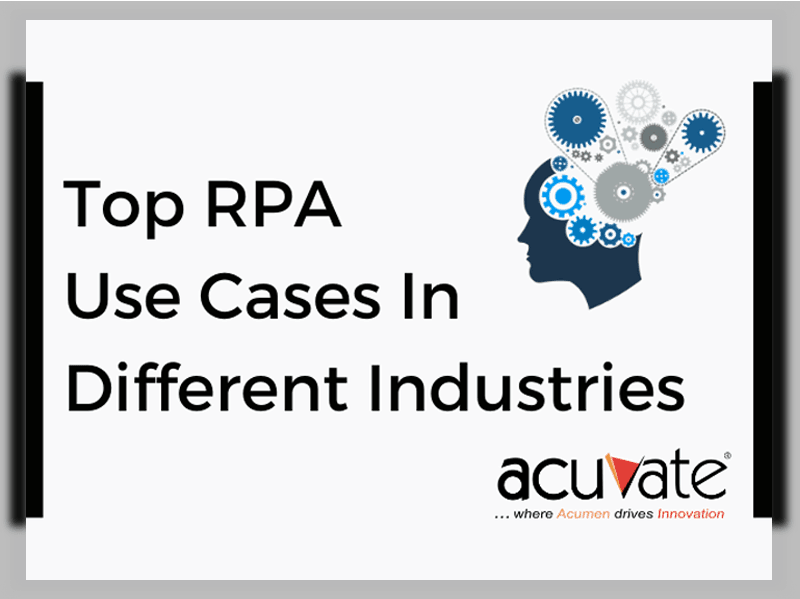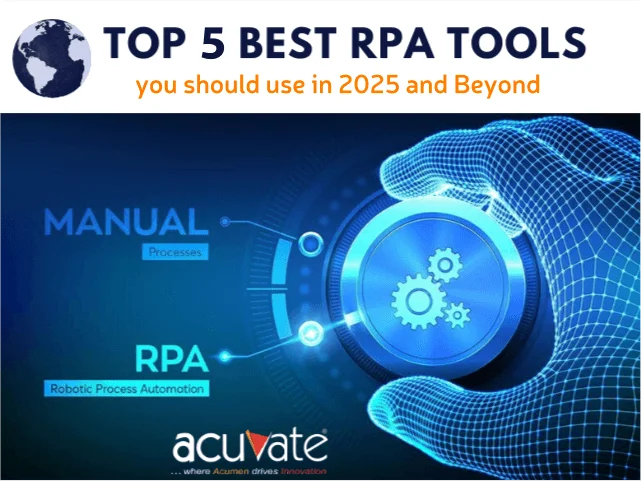The forecasted compound annual growth rate for the global robotic process automation (RPA) market is 20.3%, from $13.86 billion in 2023 to $50.50 billion in 2030. As a result of the COVID-19 pandemic, businesses have been under pressure to reduce inefficiencies by automating as many of their operations as possible. This is an essential driver for all forms of automation, and RPA is no different.
Enterprises of all sizes use RPA solutions to automate repetitive, error-prone manual tasks. Productivity, scalability, and first-call resolution are all areas where RPA has the potential to make strides across several sectors.
For example, RPA empowers manufacturing companies by automating repetitive and time-consuming shop floor tasks, reducing errors, increasing efficiency, and allowing employees to focus on more strategic and value-added activities. In the utility sector, RPA automates manual processes such as data entry, meter readings, and billing. This results in cost savings, increased accuracy, and faster response to customer inquiries and issues.
For CPG companies, too, RPA is streamlining supply chain management, reducing operational costs, and improving customer service through faster and more accurate order processing. With RPA, these companies are automating tasks such as inventory management, shipment tracking, and invoice processing, freeing time for employees to focus on more strategic initiatives. RPA also allows CPG brands to quickly adapt to changing market conditions and customer demands, increasing their agility and competitiveness across marketing and other functions.
At the helm of making these impact areas possible with powerful RPA capabilities is Microsoft’s Power Automate, along with other tools that have emerged over the years. This blog deep dives into these solutions. Read on.
What is Microsoft Power Automate
Power Automate, formerly Microsoft Flow, is a cloud-based service enabling users to create and automate workflows across multiple applications and services
It is a no-code/low-code platform to build automated workflows and business processes quickly and easily.
Power Automate: Key benefits for organizations looking to streamline workflow automation
1. Easy to use
Power Automate is easy to use, even for non-technical users. It has a user-friendly interface enabling users to create and automate workflows quickly and easily.
2. Integration with multiple services
Power Automate is a no-code/low-code platform, meaning that users can create and automate workflows without coding. This reduces reliance on expensive IT resources and enables business users to respond quickly to evolving and unique needs.
3. Low code platform
Power Automate is a no code/low code platform, which means that users can create and automate workflows without the need for coding. This reduces reliance on expensive IT resources and enables business users to respond quickly to evolving and unique needs.
4. Cost-effective
Power Automate is a cost-effective solution for workflow automation. It offers a range of pricing options, including a free plan, and can be integrated with existing Microsoft licenses.
5. Scalable
Power Automate is a scalable solution for workflow automation. It can be used by small businesses and enterprises alike and can handle large volumes of data and complex workflows.
Power Automate also offers a range of templates that enable users to create workflows quickly and easily. These include common workflows, such as approval processes, data collection and transformation, and notifications.
Where does Power Automate rank among the RPA solutions crowd?
Let’s understand their pros and cons.
Power Automate Vs Automation Anywhere
Automation Anywhere is more expensive than Power Automate, particularly for small & mid-size companies or individuals. This is because the licensing fees plus infrastructure requirements can become costly. In addition, it has a more demanding learning curve than Power Automate, thus taking longer for users to master.
Automation Anywhere has a sizable library of connectors and integrations, but it might not have as many options as Power Automate, especially for newer or specialized applications.
Also, the Microsoft Azure Cloud platform used by Power Automate is much more powerful than Automation Anywhere, with features like embedded process discovery that Automation Anywhere does not support.
Power Automate Vs UiPath
UiPath is the largest RPA solution provider in terms of revenue. It is globally recognized and targets a variety of personas, including engineers, software testers and teams.
UiPath aims to provide a no-code automation process designer tool with its Studio Web tool. In addition, UiPath has a vast partner ecosystem for supporting industry-specific automation, including pre-built assets and data-driven benchmarks for assisting the RPA deployment.
However, UiPath’s platform agnostic pay-per-use pricing model is higher than Power Automate. Also, the not very quick ticket resolution times, might not be ideal for new users and developers.
The platform also has issues reported for large-scale automation projects, such as slowing down specific processes. Another significant constraint is that UiPath does not offer crucial features like process mining, IDP and test automation.
Power Automate Vs Blue Prism
Blue Prism has a technology-agnostic deployment much like UiPath, with on-demand SaaS offering via partnerships with Microsoft Azure and AWS. In addition, it includes a variety of connectors and integrations to support Lifecycle management, process mining and RPA accelerators.
Where Blue Prism falls short is the customer service. Since there is an active merger, support and documentation might change without notice, and so do pricing and third-party integrations.
One of its more significant constraints in a rapidly evolving RPA ecosystem are slower feature updates and citizen-developer-friendly automation, attended RPA and recorder capabilities. These all indicate a more extended design cycle than other RPA solutions, especially Power Automate.
Where Power Automate shines is the seamless integration with the Microsoft 365 ecosystem. The initial cost for enterprises is discounted with the Microsoft 365 licensing, and the ease of implementation with existing Windows systems makes it a better deal than both options above.
Although the Lifecycle Management Feature requires multiple Azure components, it offers better RBAC (role-based access controls) and COE templates. Power Automate also benefits from over 500 implementation partners and community support for fixing issues that may emerge as business users and developers look to handle workflow automation independently.
Why users are migrating to Power Automate for RPA implementations
For one, as a significant enterprise tool, Microsoft brings integrations with some of the world’s most used cloud and enterprise services, including Office 365, Dynamics 365, and Azure.
Over 350,000 enterprises are using Power Automate to streamline operations, and that number continues to grow, as reported by Microsoft.
Power Automate has been the go-to solution for businesses seeking to automate operations and enhance efficiency due to its drag-and-drop interface and compatibility with other Microsoft services.
Power Automate is quickly democratizing app building, chatbot creation, automated workflows, and analytics with a low code/no code interface.
Building unique solutions to everyday business problems is simple for everyone, not just those familiar with the Microsoft ecosystem. Ultimately, this results in:
- Reduced time to value
- Project completion cost savings
- Efficiency gains
- Less time spent on product development
- Data-driven insights for better collaboration
- Lower development expenses
- Ability to prioritise strategic goals among IT staff as well as business users
There is little surprise then that Microsoft was named a Leader in the 2023 Gartner® Magic Quadrant for Robotic Process Automation. That’s some serious social proof that users leveraging Power Automate for their RPA use cases are on the right track
Looking to revolutionize your business processes and planning to migrate to Power Automate?
Look no further than Acuvate – your trusted partner for cutting-edge RPA superpowers, delivered in a matter of days. As a Microsoft Gold Partner, Acuvators have worked extensively on the Microsoft stack. Power Platform and Power Automate are no different.
But that’s not all. To boost our RPA capabilities and deliver the very best to customers, Acuvate has also partnered with Blueprint Software Systems, a global software company that helps companies assess, improve, and migrate their automation estates. This strategic collaboration is designed to help our customers accelerate their RPA migration to Power Automate at minimal cost and maximum efficiency. It will remove the complexities and reduce the time & cost, delivering a comprehensive solution to customers looking automate their processes and operations for maximum ROI.
Acuvate’s RPA experts are now equipped with technical know-how and crucial collaborations to take your business process automation to the next level, no matter how complex the workflow.
- Improve efficiency.
- Reduce costs.
- Enhance productivity
- All while freeing up your employees to focus on more superior tasks.
It all starts here. Get in touch – let’s get your RP No code/low code A show on the road!



